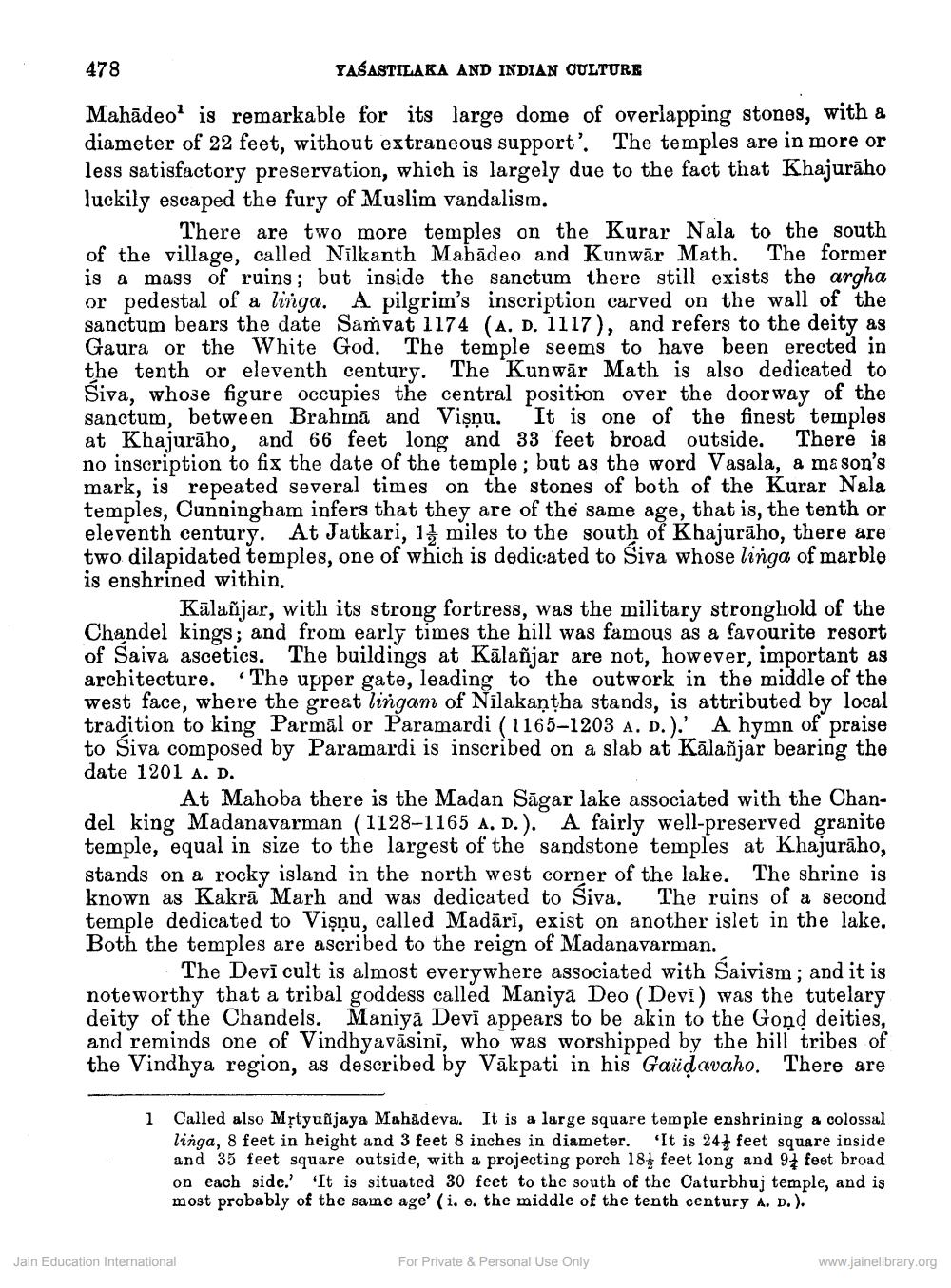________________
478
YAŠASTILAKA AND INDIAN CULTURE
Mahādeo is remarkable for its large dome of overlapping stones, with a diameter of 22 feet, without extraneous support'. The temples are in more or less satisfactory preservation, which is largely due to the fact that Khajurāho luckily escaped the fury of Muslim vandalism.
There are two more temples on the Kurar Nala to the south of the village, called Nilkanth Mahādeo and Kunwār Math. The former is a mass of ruins; but inside the sanctum there still exists the argha or pedestal of a linga. A pilgrim's inscription carved on the wall of the sanctum bears the date Samvat 1174 (A. D. 1117), and refers to the deity as Gaura or the White God. The temple seems to have been erected in the tenth or eleventh century. The Kunwār Math is also dedicated to Śiva, whose figure occupies the central position over the doorway of the sanctum, between Brahma and Vişņu. It is one of the finest temples at Khajurāho, and 66 feet long and 33 feet broad outside. There is no inscription to fix the date of the temple ; but as the word Vasala, a ma son's mark, is repeated several times on the stones of both of the Kurar Nala temples, Cunningham infers that they are of the same age, that is, the tenth or eleventh century. At Jatkari, 14 miles to the south of Khajurāho, there are two dilapidated temples, one of which is dedicated to Śiva whose linga of marble is enshrined within.
Kālañjar, with its strong fortress, was the military stronghold of the Chandel kings; and from early times the hill was famous as a favourite resort of Saiva ascetics. The buildings at Kālañjar are not, however, important as architecture. The upper gate, leading to the outwork in the middle of the west face, where the great lingam of Nilakantha stands, is attributed by local tradition to king Parmāl or Paramardi ( 1165-1203 A. D.).' A hymn of praise to Siva composed by Paramardi is inscribed on a slab at Kālañjar bearing the date 1201 A. D.
At Mahoba there is the Madan Sāgar lake associated with the Chandel king Madanavarman (1128-1165 A. D.). A fairly well-preserved granite temple, equal in size to the largest of the sandstone temples at Khajuraho, stands on a rocky island in the north west corner of the lake. The shrine is known as Kakrā Marh and was dedicated to Siva. The ruins of a second temple dedicated to Vişnu, called Madári, exist on another islet in the lake, Both the temples are ascribed to the reign of Madanavarman.
The Devī cult is almost everywhere associated with Saivism ; and it is noteworthy that a tribal goddess called Maniya Deo (Devi) was the tutelary deity of the Chandels. Maniya Devi appears to be akin to the Gond deities, and reminds one of Vindhyavāsini, who was worshipped by the hill tribes of the Vindhya region, as described by Vākpati in his Gaidavaho. There are
1 Called also Mrtyužjaya Mahadeva. It is a large square temple enshrining a colossal
linga, 8 feet in height and 3 feet 8 inches in diameter. 'It is 24 feet square inside and 35 feet square outside, with a projecting porch 18 feet long and 9 feet broad on each side.' 'It is situated 30 feet to the south of the Caturbhuj temple, and is most probably of the same age' (i. e. the middle of the tenth century A. D.).
Jain Education International
For Private & Personal Use Only
www.jainelibrary.org




